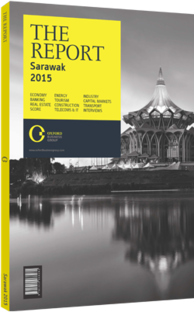OBG talks to Richard Curtis, Group Managing Director, Cahya Mata Sarawak

Interview: Richard Curtis
What are the current drivers of growth in Sarawak’s construction sector outside of the Sarawak Corridor of Renewable Energy (SCORE)?
RICHARD CURTIS: The main areas of focus moving forward are potential investments in energy-intensive industry and extending involvement in infrastructure and related services within Sarawak, both in SCORE and elsewhere. While the construction sector has been heavily involved in developing the cities and areas contained within SCORE, which currently forms the heart of the state’s economic growth, opportunities exist elsewhere for the construction sector as well.
The major drivers of continued growth in the construction sector include normal economic growth, industrial investment, population growth and urbanisation. In Kuching specifically, recent years have seen a growing number of factories and industrial investments come to the city, and the construction sector naturally benefits from this. Population growth, which currently stands at about 1.9% in Sarawak, and urbanisation, which the state is experiencing at a rate of about 6%, are also crucial, as both factors create a need for more homes and spur construction forward.
In terms of the geographical evenness of development and growth as it pertains to construction, it is important to note that industrialisation is key to reducing income disparity, as it creates large quantities of skilled and semi-skilled jobs, leading to higher incomes. In rural communities based on agriculture, it is very hard to earn enough to reduce income disparity. Thus the development focus for Sarawak now is not just on driving GDP but also on reducing income disparity by creating jobs of high economic value.
What major challenges are associated with Sarawak’s current fast-tracking of construction works to keep up with rapid economic growth?
CURTIS: What is important to remember is that Sarawak has already undertaken a fast-tracked development project on a large scale in the past. When Bintulu first opened up to the liquefied natural gas industry, it was a small fishing village of just 15,000 people, whereas today the city has a population of more than 200,000. What started with foreign workers living in government-owned quarters and rented homes has evolved into an almost fully local workforce living in a vibrant community. We must, therefore, look to this example of a rapidly developed township as showing what is possible when facing the challenges of modern demand for construction works. The rate and scope of foreign investment Sarawak is experiencing, and the speed with which new industries are establishing themselves in the state, are of course greater now than ever before, but much can be achieved by applying modern expertise with historical lessons in mind.
What impact will implementation of the Goods and Services Tax (GST) in 2015 have on the industry, and which parties will bear the brunt of this cost?
CURTIS: The Goods and Services Tax (GST) is a progressive taxation model that has been successfully implemented in many countries, and it is very efficient. While the implementation of the tax on April 1, 2015 will result in slightly increased costs in the first year, it is not expected to have a major, sustained economic impact so much as a short-term psychological one. People will likely rush to buy houses and cars prior to the implementation and a lull will follow, but shortly thereafter things will resume to normal.
According to recent statistics, the consumer price index in Sarawak is rising by an average rate of 3.3% a year. The GST’s impact on the cost of living will be to add another 1.8% to that in the first year after implementation, and this additional increase will then scale back in the years to follow. So while there will be a short-term impact, in a buoyant economy like Sarawak’s, well-run and successful companies can afford to provide wage increases for their employees which are well in excess of cost of living increases, and hence the impact of the tax on the public is likely be mitigated.
You have reached the limit of premium articles you can view for free.
Choose from the options below to purchase print or digital editions of our Reports. You can also purchase a website subscription giving you unlimited access to all of our Reports online for 12 months.
If you have already purchased this Report or have a website subscription, please login to continue.

